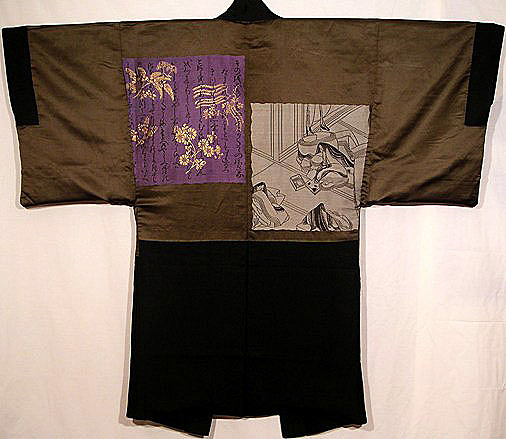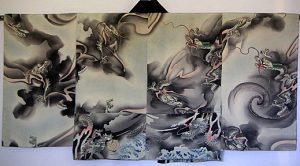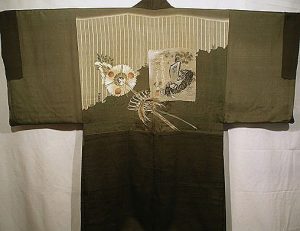Description
This is an extraordinary example of a Japanese Man’s “Haori” or formal topcoat. It is entirely hand woven, handmade, totally reversible, and has represented the height of formal ware for Japanese men for centuries . The outer layer of the garment is a very heavy, high quality, solid black Satin Silk with the exception of 5 white circles within which a pictorial symbol of the Family Crest or “Mon” has been painted. This family crest is the Wood Sorrell (“Katabami”) which is also referred to as the Mirror Plant or “Kagamigusa,” because the leaf of the plant was used to polish the bronze mirrors of old. However, in its use as an heraldic device, it was most often portrayed by a trifoliate clover like leaf which was divided by a sword blade as shown below. This pattern was particularly popular among the military class.
What makes the Haori for men so intriguing is the fact that the main source of decoration is on the inside back lining panel of the garment. To include such artistic decoration on an inner lining reflected the idea that real luxury was found in hidden places, and did not consist of overt displays. This concept was incorporated into what the Japanese called “Iki,” fashionable in the late Edo/Early Meiji Eras. This concept reflected the wearers exquisite sense of beauty without betraying one’s sense of style to the outside world,
The inner back panel of this dramatic Haori has been hand woven in an unusual triptych- type design. On the left hand portion, the artist has chosen the powerful and unusual shade of purple, a color that was reserved for members of the Imperial Family. The block resembles the page of a book on which has been reproduced a portion of “The Tale of Genji,” the most famous novel of the 11th Century. Superimposed over that are the Wisteria (“Fuji”) and the Chrysanthemum (“Kiku”). The Chrysanthemum is the flower of the Imperial Family; while the Wisteria, with its beautiful clusters of flowers, is symbolic of long life, prosperity, and good fortune. It has also enjoyed a long association with the Poets of the Court. Reinforcing the Court connection is the Art Work on the right hand block depicting a scene from the famous novel itself.
The finer the skill of the Master Weaver, the finer the design that appears within the Haori. Only a man of great wealth and very high status within Court Society of old Japan would have been able to wear such a magnificent garment. A work of art that remained a treasured heirloom for many years.
A Certificate of Authenticity is included.
TTAC will personally pack and ship via UPS at company expense within the continental U.S.









